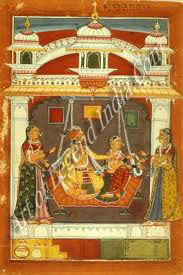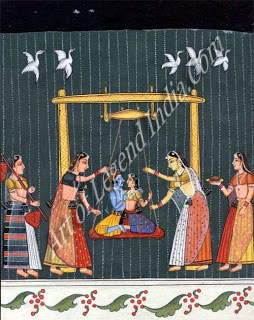 Hindola
Raga
Hindola
RagaAn inscription in the upper yellow panel of this painting identities it as Hindola Raga and states that it is the third (raga in the iconographic system). There is a lengthy passage on the back oldie painting that describes the gem-encrusted swing and the beauty and ornaments of the Lord Hindola. Hindola Raga is unique insofar as it is the only musical mode represented by the same basic visual imagery regardless of the iconographic or geographic system. The iconography used for the raga is derived from its name, Hindola, meaning "swing," which is the predominant visual feature of the paintings. It is a morning melody associated with the rainy season, especially the Indian month of Chaitra. Accordingly, burgeoning rain clouds and storms are often portrayed in the literary and pictorial illustrations of Hindola Raga.
 Besides the set motif of a
swing, there are varying numbers of participants in the scene. Typically, a
hero or Krishna is shown seated on the swing, usually with a heroine but
sometimes alone. Also present are several musicians and attendants, mainly
female, one of whom waves a flywhisk over the protagonist(s). This example
shows Krishna holding a vina and seated on the swing with a lady while being
attended by tbur hand-maidens, one of whom holds a tambura. A row of dark storm
clouds fills the sky, and rains are cascading.
Besides the set motif of a
swing, there are varying numbers of participants in the scene. Typically, a
hero or Krishna is shown seated on the swing, usually with a heroine but
sometimes alone. Also present are several musicians and attendants, mainly
female, one of whom waves a flywhisk over the protagonist(s). This example
shows Krishna holding a vina and seated on the swing with a lady while being
attended by tbur hand-maidens, one of whom holds a tambura. A row of dark storm
clouds fills the sky, and rains are cascading. 










0 Response to "Indian Painting - Hindola Raga"
Post a Comment